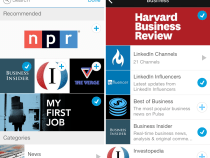
LinkedIn, the social network for the working world now with 259 million users, is today taking the covers off its latest moves to make itself more than just a place that people visit when they’re hunting for their next job (or employee). It is integrating Pulse – the social newsreading app it acquired in April 2013 for $90 million – into its main homepage; and it is now providing a social sign-on within the newest version of the Pulse app, out today on iOS and Android.
The changes – which were first previewed last month – will also see LinkedIn dropping LinkedIn Today, the in-house social reading service that the company launched in 2011.
While LinkedIn Today was the company’s original attempt to make individual users’ home pages more dynamic, perhaps that particular mix of “professional” content around certain subjects, complemented by stories shared by their networks, has not really done the job well enough. What this will give LinkedIn is a mainline to a lot more engaging content beyond the standard fare of Richard Branson expounding on what makes for a compelling entrepreneur.
A spokesperson for LinkedIn confirmed that fundamentally Pulse is keeping its own business on the same course as before: lots of content deals with third-party publishers that will continue to expand over time. “The relationships Pulse has will stay intact and a selection of these publishers will also be accessible now on LinkedIn.com,” she says. But it will also see more of that content come to LinkedIn. “Folks like The New Yorker and Al Jazeera are new publishers to linkedin.com side and will now be able to be followed by LinkedIn members within the Pulse experience on LinkedIn.com.” She notes that the company does not break down the total news sources “but there are hundreds.” Presumably, more will be coming to the desktop experience over time.
Ankit Gupta, one of Pulse’s co-founders who is now a product manager at LinkedIn, notes that there will be more LinkedIn-friend social features.
“In addition to a brand new visual refresh of the Pulse app, now social actions like commenting and liking on Pulse are possible for the first time and will sync with your LinkedIn.com experience,” he writes in a blog post. “Any channels you follow on LinkedIn will also automatically sync across your Pulse app experience. It also means that the professional news you’ve come to expect and rely on from LinkedIn just got better – infused with added discovery and navigation functionality as well as expanded publisher content.”
For those who are downloading the new Pulse app, they will be given an option to synchronize it with LinkedIn by filling in the new sign-in with their LinkedIn credentials. Users who choose to use Pulse without that will continue to be able to do so but the LinkedIn sign on will give them more recommendations and features such as saved reading lists.
To note, this is not the first instance of signing on via LinkedIn on a third-party site. You can get the plug-in here if you are a developer. But I suspect that this is a feature that LinkedIn will be pushing more in the future, as part of its larger ambition to become the controller of the “professional graph” to complement Facebook’s control of the “social graph” – something that CEO Jeff Weiner has discussed at some length in the past. This makes a lot of sense: if you think about the huge amount of business-related content in apps and online today, a single sign-on connecting that, in the way that Facebook and Twitter offer in consumer apps, could be useful.
For the past year, LinkedIn has been making a lot of efforts to improve user experience across its desktop and mobile versions. That’s included improved search and mobile contacts features, as well as new ways of using the platform to find and apply for jobs. These latest moves addresses a couple of points for the company:
First, it will help give more integration between those desktop and mobile versions of the service by taking a mobile-first experience to desktop. It’s important to note that this is not parity as such: different screens will by their nature demand different kinds of engagement, and LinkedIn has come to realise that creating apps that highlight specific aspects of its service, such as managing your contacts, or reading (via Pulse) may be the best way of speaking to its growing population of mobile consumers.
Second, I think that LinkedIn is hoping that replacing LinkedIn Today with Pulse will help it improve the amount of time that people spend on the site, and the reasons that they go there – which will help the company sell more advertising against those users. The stereotype of LinkedIn, built up over many years of non-development, is that it is a site people visit most when they are looking for a new job, or looking to hire someone for a particular vacancy. To go along with that, the majority ($225m) of the company’s revenues in the last quarter came from Talent Solutions catering to that area. But LinkedIn is pushing ahead to diversify into ads and other revenue streams like premium subscriptions: increasing user numbers, and user engagement, will be essential to do that.
Read more : LinkedIn Drops LinkedIn Today For Pulse Newsreader; Integrates LinkedIn Sign-On Into Pulse’s Updated App

0 Responses
Stay in touch with the conversation, subscribe to the RSS feed for comments on this post.